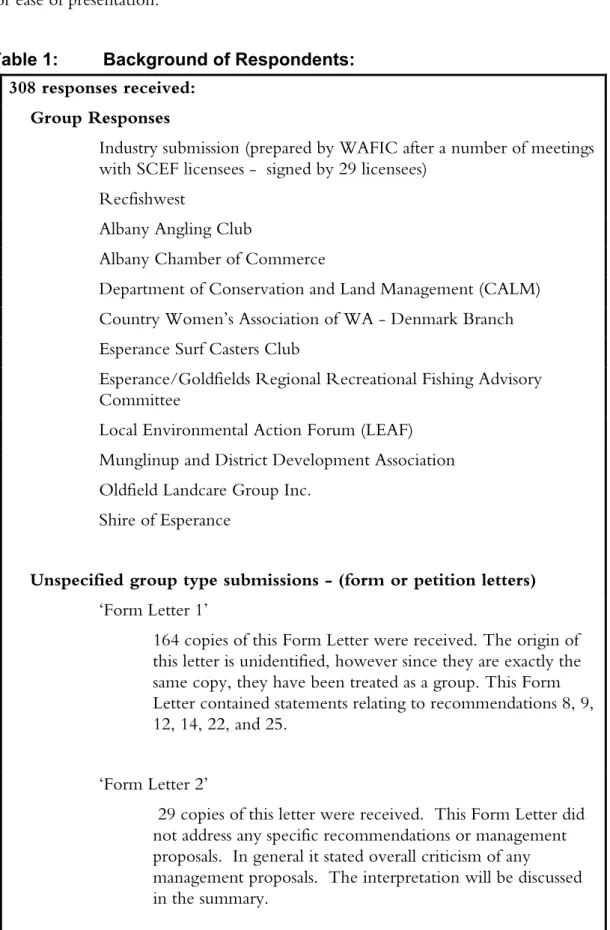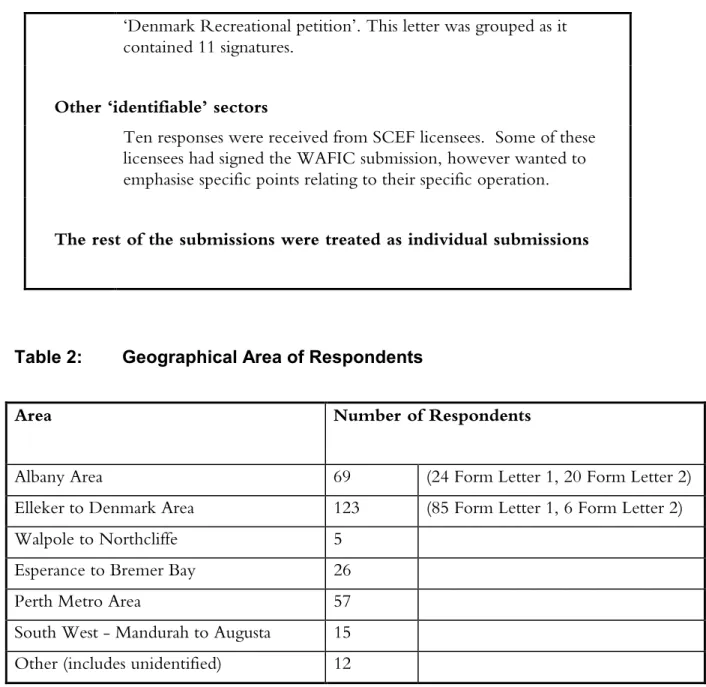Fisheries Management Paper Number 126, 'South Coast Estuarine Fisheries - Discussion Paper', presented a number of management proposals for stakeholder consultation as a way forward to address ongoing, current and long-term sustainable management issues Fisheries and sharing issues resources that exist. Fisheries WA undertook an extensive three-month public consultation process as part of the management review. To help people respond to the recommendations, a submission form was prepared after the paper was printed.

SUMMARY OF RESPONSES TO STAGE 1: INTRODUCTION OF CONSISTENT LEGISLATION AND MANAGEMENT TO EFFECT
Legislative Base (Recommendation 1) Recommendation 1
Definition of the Fishery (Recommendation 2) Recommendation 2
However, license holders did not support the closure of Parry, Fitzgerald and Torradup bays, stating that they "fished occasionally and provided fish that would have to be sourced elsewhere if closed". The committee and the majority of individual contributions supported the definition of fisheries by naming estuaries open to commercial fishing in the list. Several submissions commented that the consolidation and clear definitions of the legislation were a positive step and strongly supported the exclusion of some estuarine systems, particularly the Gardner River, Fitzgerald Inlet and Torradup Inlet.
For example, Recfishwest and several other groups stated that they were not in favor of continued commercial and recreational net access to Stokes Inlet. Recfishwest stated that it firmly believes that further estuaries should be closed to ensure a tangible resource shift resulting from the use of public funds through the Fisheries Adjustment Schemes. Based on this, Recfishwest stated that the timetable should be established to facilitate the closure of additional estuaries in the future.
A recreational angler requested that Waychinicup Inlet be excluded from the definition of the fishery and suggested at least implementing a net ban in Waychinicup as it is a very small inlet often used by school groups, families and recreational anglers.
That the boat replacement policy be streamlined to allow suitably approved vessels to be replaced by boats up to 6.5 metres. That fishing units in excess of the proposed number be permitted to renew their FBLs for the remainder of the life of the boat, but not beyond January 1, 2005. That the primary fishing vessel and associated dinghies may only be permitted to operate simultaneously , when used in connection with the specific fishery carried out by the holder of the permit.
Auxiliary boats may only be used within the defined areas of the fishery, unless otherwise authorized. Instead, it proposed that the operation of those dinghies should be restricted so that the licensee is only allowed to operate a maximum of two dinghies at any one time with the primary fishing boat during a fishing session. In support of Recommendation 4, which relates to streamlining the boat replacement policy for the Fisheries, one licensee criticized the time taken by the current process.
The industry stated its agreement in principle to Recommendation 6, provided licensees' ability to use. Recfishwest agreed in principle, but did not support the words "unless otherwise permitted" at the end of the text and expressed concern that the dinghy could be attached to another license and could not be used in estuarine fisheries .
In relation to the phase-in period for the boat definition (recommendation 5), the industry submission stated that under its preferred scheme for the definition of a fishing unit (recommendation 3), recommendation 5 would not be relevant and therefore no response is recorded. . They stated that although a long-term average or upper limit could be set, catches and. While this principle was endorsed, the concern of licensees was that the traditional or historical level of catch will continue to be eroded."
Recfishwest stated that it would like to see catch reference figures as part of the final report. It also stated that the two-year 'show cause1' clause should be invoked for all fishermen with no significant history. Recfishwest also stated that it would not like to see history levels set so that the maximum number of commercial fishermen remain in the fishery.
One of these submissions cautioned against using historical catches as reference points without a program to monitor fish population dynamics due to the ongoing environmental changes occurring in the catchment. Form Letter 2 expresses concern that the discussion paper is far too serious and raises concerns about the fish supply.
Weekend, Public Holiday Closures and Daytime Set Net Closures (Recommendations 8 to 10)
The industry recommendation and several other submissions did not support the recommendation of full weekend closures because they felt that closures would affect market demands and limit fishing time, especially in winter when fishing is more weather dependent. Similarly, Form Letter 1 proposed a one-day only closure (Saturday closure) for the summer period only, and that weekend and holiday closures apply year-round to trawl fishing. Similarly, several permit holders and individual submissions suggested that Saturday night closures should only be introduced for the summer period (proposed 1 December to 1 May) due to poor weather in winter and on the basis that it is implemented during the rest of the year less recreational fishing.
The industry submission stated that licensees agreed, in principle, to be closed for certain public holidays on the condition: That if the public holiday falls on a Friday or Monday, the closure should only be on Saturday and Sunday evenings. This was based on the view of the majority of licensees that they wished to retain the ability to fish on Friday evenings).
The industry submission agreed in principle to daily closures, but requested that the closures start two hours after sunrise and that a set time be specified. The industry role and several license holder roles raised concerns that it was occasionally physically impossible to haul nets in this time frame due to the large quantities of fish requiring longer time to sort the catch.
Permitted Gear and Method (Recommendation 11 to 21)
Six individuals who support the gear definition and a further seven who do not support the recommendation noted that seine nets should be banned either from the Fishery or from specific inlets (especially Wilson Inlet). The industry submission stated that licensees did not support the limit on trawl/seine to a maximum of 500m and suggested that the maximum allowable trawl/seine was 600m (one fisherman requested 700m). Nine respondents who did not support the recommendation noted that they preferred a ban on seine nets (some stated in Wilson Inlet, others did not specify) and.
That the minimum mesh size for set nets to be used in the southern coastal estuary fishery is 63mm. The industry submission did not support the proposed minimum mesh size of 63 mm for set nets, citing concerns that most whiting would go to sea before being caught and be lost to the fishery. While many submissions supported recommendation 13, many did not comment on the minimum mesh size of 63mm.
Two submissions did not support the use of fishing traps in estuaries at all, citing problems with bycatch such as the capture of squid. The industry submission and several licensees did not support the recommendation that hand-held spears and gaffs should be allowed for taking out fish (when they fall out of nets), occasional catch of cobbler (and other species) and safety (when removing). of species such as rays from nets).
SUMMARY OF RESPONSES TO STAGE 2: DETERMINING THE OPTIMUM NUMBER OF COMMERCIAL FISHING UNITS AND
This proposal was recommended primarily to address Fisheries WA's concerns in relation to the latent response capacity in the event of a license transfer. Depending on the number of licenses taken as a result of the current fisheries adjustment scheme, the above package is likely to leave in the order of 6-8 'half licences' (ie 1000m). The half licenses should then be allowed to be merged by transfer, leaving at most 23 or 24 full licenses in the fishery.
Form Letter 1 derived support for a reduction in the number of fishermen, stating that portability should be introduced into the fishery when the number of fishermen increases. That a voluntary fisheries adjustment scheme be reactivated in fisheries to run in parallel with the proposed management arrangements. However, license holders stated that if transferability is not granted, the Fisheries Adjustment Scheme should only accept buy-back offers until a minimum of 23 or 24 licenses remain in the fishery.
As previously noted, this was considered by the license holders to be the minimum number of operators in the fishery necessary to maintain an economically viable fishery. Recfishwest supported the re-opening of the Voluntary Fisheries Adjustment Scheme on the condition that some estuaries be closed to create an explicit shift in the resource shares rather than only being used to restructure the commercial fishery and increase the profitability of remaining operators.
RESPONSES RELATING TO STAGE 3: ISSUES AND OPTIONS FOR AREA SPECIFIC MANAGEMENT AND FURTHER RESOURCE
Grandfather clause must be granted immediately upon death or illness or injury of licensee. That transferability must be linked to training, with only people who obtain an appropriate certificate qualifying for the licence.
Wilson Inlet Options 1 to 3 Wilson Inlet Option 1
Limit numbers in specific estuaries (one said, “What happens if all 15 show up in Wilson Inlet.
Option 2 Option 3 Submission
Reduce the number of licensees who can access Stokes Inlet by exploring the possibility of a specific Fisheries Adjustment Scheme to remove access rights in the Inlet, with restrictions on future access for the remaining licensees. Address the catch share concerns in Stokes Inlet by considering introducing a minimum mesh size that will facilitate both an increase in the catch share and Extend the period of the existing commercial seasonal closure, December 1 to April 31 of the following year, by closing the Inlet earlier or later in the year.
Option 2 Option 3 Option 4 Submission
- Irwin Inlet Option
- Restocking of Natural Waterways Restocking Recommendation 1
- GENERAL COMMENTS NOT RELATING TO SPECIFIC RECOMMENDATIONS
- General Comments Relating to Sustainability, Resource Sharing and Fishing Viability and Enforcement
- General Comments Relating to Latent Effort
- General Comments Relating to Management Costs
- SUMMARY
Recfishwest stated that it has previously requested that Stokes Inlet and Wilson Inlet be closed to commercial fishing. Recfishwest supports Stokes Inlet Option 4 without any payment of compensation (see Wilson Inlet Options for rationale). There is a view that the estuary is part of Stokes Inlet National Park and should therefore be free of any commercial activity, just as the land in the park is now.
Stokes Inlet is considered one of the most important recreational fishing grounds in the Esperance region due to its relative proximity and ease of access. Banning all nets from Stokes Inlet would allow recreational anglers to catch a reasonable size of fish without a major impact on the commercial fishing industry. Stokes Inlet is one of the few inland waterways in the vicinity of Esperance suitable for tackle and fly.
The professional fishermen who fish Stokes Inlet all come from the area and bring their own. Several submissions stated that a complete closure of Stokes Inlet may force licensees who fish this inlet into other estuaries such as Wilson Inlet.
